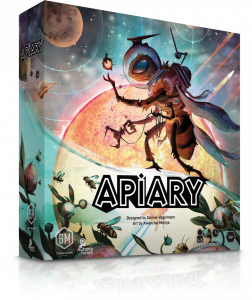 Over the last 2 years I’ve had the great privilege of working with debut designer Connie Vogelmann on her game, Apiary. From start to finish, I’ve been in awe of Connie’s design skills, dedication, communication, creativity, and ability to put herself in the shoes of the player. I’m so excited to share this game with you, and today Connie is going to share 7 lessons she learned during the Apiary design process.
Over the last 2 years I’ve had the great privilege of working with debut designer Connie Vogelmann on her game, Apiary. From start to finish, I’ve been in awe of Connie’s design skills, dedication, communication, creativity, and ability to put herself in the shoes of the player. I’m so excited to share this game with you, and today Connie is going to share 7 lessons she learned during the Apiary design process.
For context, Apiary is about spacefaring, technologically advanced bees. It’s a speculative future featuring exploration, hive expansion, engine building, and a unique worker-placement system using 4-sided workers whose strength level determines their action benefits. It includes over 100 illustrations from Kwanchai Moriya.
Here’s Connie, who you can also hear from in the Apiary design diaries.
***
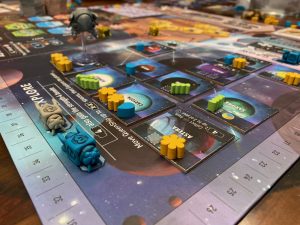 Apiary was my first real game design experience. Going through the process – and working with Stonemaier – has taught me a lot! By sharing my experiences, I hope to inspire others, and help them avoid some of the pitfalls I fell into.
Apiary was my first real game design experience. Going through the process – and working with Stonemaier – has taught me a lot! By sharing my experiences, I hope to inspire others, and help them avoid some of the pitfalls I fell into.
Enjoy the Process
Apiary has been in my life for almost 5 years. I’ve easily spent hundreds of hours designing and prototyping, and spent significant mental and emotional energy working to bring the game to fruition. I found the process to be incredibly rewarding, but it took a lot of sustained commitment (and a healthy dose of luck along the way). I don’t recommend that anyone start designing games solely in pursuit of eventual publication; you may spend years designing a game that will never see the light of day, so it’s critical that you get satisfaction and enjoyment out of the design process.
Learn Games & Game Design (Realistically)
Many designers, myself included, balance design work with full-time jobs, family responsibilities, and the external hobbies and activities that make us well-rounded people. As important as it is to “study the craft,” both by designing and playing games, it’s equally important to set realistic expectations. In the game design space, you’ll often see humblebrags by people who “only” managed to play 10 in-person games in a week – and this can be incredibly demoralizing for those of us who manage far less than that. I supplement my limited gaming time with board game podcasts and videos, so I can stay up-to-date and learn, even when I’m not able to get a new game to the table. Whenever I’m commuting, doing chores, or exercising, I’m also listening to a podcast or video.
Some of these are from regular board game content creators (including Brothers Murph, Board Game Hot Takes, Talk Cardboard, Meeple Town, Two Wood for a Wheat, and Punchboard Paradise), and others are specific to game design (including Ludology, Board Game Design Lab, Building the Game, and Board Game Community Show). The weekly Cardboard Edison newsletter is also a great way to learn what’s going on in the board game design world, and is well worth the $5 monthly subscription fee.
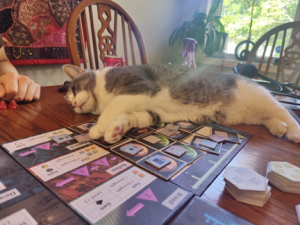 Find a Playtesting Group
Find a Playtesting Group
Games never play out on the table the way they do in your head. Getting a game to the table is the best possible way to make progress in designing and developing your game. This is especially true if you are able to playtest with other designers. Especially early in the design process, other designers not only help identify problems, but may also be able to articulate the source of the problem and help brainstorm solutions. When you return the favor (by playtesting their games), you will also improve your own design skills. If you don’t have access to an in-person design group, there are some great online playtesting groups. I highly recommend checking out Break My Game, which has several scheduled online playtesting events each week.
Listen to (the Right) Feedback
When I first started playtesting Apiary, I was determined to listen to all feedback that I received. I had been a playtester in more than one game where it was abundantly clear that the designer was not listening to my feedback. This was not only disrespectful to me as a playtester, but almost invariably, these games weren’t very good. When I started designing, I was determined to take every comment I received seriously, to a ludicrous degree (at one point, I spent time trying to turn Apiary into a deck-building game). In short, it’s about finding balance.
I’ve found that when a playtester identifies something that feels bad or negative, it’s important to take that feedback seriously. It’s almost never a one-off or isolated complaint. A playtester may not correctly identify the underlying problem or know how to fix it (that’s my job!) but they are very good at identifying what feels bad or isn’t working. In addition, the more playtests you run, the better you become at guiding playtesters – letting them know what kind of game you’re designing, what feeling you’re hoping to inspire, and what kind of feedback you’re looking for.
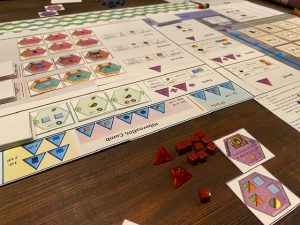 Prototype Smarter (Not Harder)
Prototype Smarter (Not Harder)
In the beginning, I laminated all of my pieces, spent hours cutting hexagonal pieces, and glued all my printouts to cardboard tiles. In short, I wasted a ton of time. Although every designer will be different, I have found that I completely redo anywhere between 50% and 100% of my printed components between every playtest, especially early on. Now, I live off cardstock and scotch tape. The more time you spend making a prototype, the higher the mental barrier will be to making changes. I strongly discourage designers from ordering custom-printed components, except perhaps for a final version to pitch to publishers. The time and cost associated with custom-printed components is high, and I think there’s an even higher “hidden” cost associated with “locking in” your game early, instead of remaining flexible and continuing to improve your game.
Even my final prototype of Apiary for Stonemaier was something that I printed at home. (And here’s a pro tip that I learned from Jamey: If you’re working with hexagons, you can use offset squares – like a brick wall – to accomplish the exact same thing in a fraction of the time!). I’ll note that I don’t quite take the “shotgun” approach to prototyping that a lot of other designers do. It will often take me a week to put together a new prototype, as I often do a lot of design work while updating each component, but I try to spend as much time as possible designing, and as little time as possible interacting with the actual prototype.
[Jamey: I wanted to add that Connie did something really smart in the initial game submission: She separated the various tiles into different bags, and she labeled the bags. Those labels made it so much easier for us to learn the game!]Learn Design Software
I made the first 20 or so versions of Apiary in Microsoft Word (you read that right). It does work, but only barely. I finally learned NanDeck a couple of years ago, and wish I had switched sooner. Because I have no coding experience, there was a fairly high barrier to entry, and it took me a solid day to create my first template. (Ludo Lodge has a couple of great tutorial videos for NanDeck.) This initial investment has saved me hundreds of hours since then. Being able to link a spreadsheet, including formulas, directly into your template makes prototyping infinitely faster than doing it by hand, and opens up a lot of additional design options. There are other software options out there (a lot of pros use InDesign), but NanDeck (which is free) has served me well.
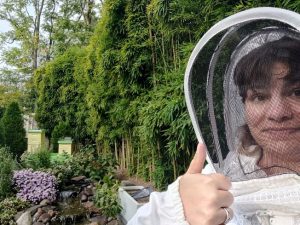 Bees Are Super Cool!
Bees Are Super Cool!
This is a little off-topic, but I wanted to take a moment to say how cool bees are. I started keeping bees a couple of years ago in my Washington, DC backyard, and I continue to be amazed by them. For all that they are simple (and short-lived) creatures, they have incredibly complex processes – from waggle dances (where they communicate good foraging locations to each other), to air conditioning (they bring back water and fan it around the hive for cooling), to taking on differentiated responsibilities within the hive – they are truly fascinating creatures!
***
Thank you so much, Connie, for taking the time to share these thoughts and to design such an incredible game. If this piques your interest, dear reader, you can sign up for Apiary updates and an October 4 launch notification (shipping will happen in October). For every launch notification request we receive before October 4, Stonemaier Games will donate $1 to Pollinator.org, the Center for Native Pollinator Conservation, or Heifer International (honeybee gift).
If you gain value from the 100 articles Jamey publishes on this blog each year, please consider championing this content! You can also listen to posts like this in the audio version of the blog.
12 Comments on “7 Lessons Learned Designing Apiary (by Connie Vogelmann)”
Leave a Comment
If you ask a question about a specific card or ability, please type the exact text in your comment to help facilitate a speedy and precise answer.
Your comment may take a few minutes to publish. Antagonistic, rude, or degrading comments will be removed. Thank you.


Great article and all excellent advice. I’m similar in that I will spend a bit of time designing/balancing the content (such as cards and tiles) while updating the individual prototype components. So it can take a week to fully update a prototype. But generally agree to keep prototypes simple so you can get to the next playtest as fast as possible.
Thanks for sharing!
Thanks so much for sharing your experience with Apiary! I’d love to know which part of the creation process did you begin with, and which parts of creation were most difficult for you! And this goes for everyone who sees this and creates games. Creating a game from scratch has always been intimidating to me, but it’s something I want to begin.
This was a great and enjoyable read. Thanks for sharing it!
Very interesting, hope the game launch goes well. Some good advice. Would be interested to know at what point you decided to make the theme bees in space rather than just bees
Thanks James! The sci-fi twist was something I suggested to Connie after I learned about the game at Design Day. If you’re curious about this and other design stories, check out the design diaries that Connie and I put together: https://stonemaiergames.com/games/apiary/design-diary/
The advice to make simple prototypes is so hard to follow. But you’re totally right. If you make fancy home-made components, you’re a lot less likely to change them and that makes you resistance to valid feedback.
Great article. Thanks so much for sharing your experience. I’d love to hear more.
Listening is a great lesson to learn, as it keeps the people who make the sacrifice of telling – engaging after they sacrifice. It is easier to identify pain than pleasure, so being able to link the two is an enormous skill. Im looking forward to reading and experiencing more SM things, including Apiary. Thanks for submitting it to us to try out.
Connie just gave me so many things I need to check out! I’m not planning to design a game any time soon, but the resources she linked look fascinating for a board game enthusiast. Thanks!
Ha! When I first saw this game, I thought “the designer must be really into bees!”. Turns out, I was right!
I agree, I am planning on checking them out too. And looking forward to exploring more of Jamie’s website too, i’ve only been watching his videos on Youtube. I also bought the audiobook Jamie mentioned as something Connie should read. It’s pretty awesome
Great list of lessons learned! I can’t wait to get a copy of Apiary! It sounds like a great game! Congrats on getting it published!